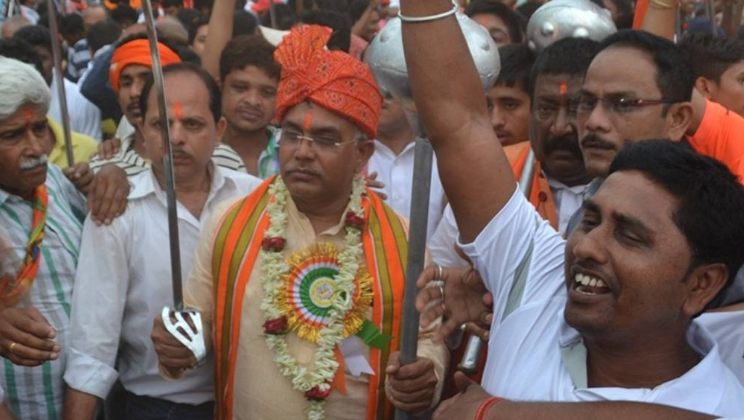BJP rath-yatra in December and RSS foundation day rallies on Bijoya Dashami major worry for the Mamata Banerjee government
Three massive rath-yatras to be taken out by the Bharatiya Janata Party (BJP) in December and January 2019 for 35-40 days all over West Bengal is giving the Mamata Banerjee government sleepless nights.
Added to that, Bijoya Dashami/Dussehra which marks the foundation day of the Rashtriya Swayamsevak Sangh (RSS) will be celebrated with rallies throughout the state.
These programmes – the RSS rallies in October and the BJP’s month long rath-yatra plan after that – have been a cause of worry for the state government. The government must ensure that law and order situation is under control, and for the Trinamool Congress, such massive programmes by opposition forces pose big challenge to the ruling party politically.
The BJP rath-yatra plan
BJP state president Dilip Ghosh said that the rath-yatras are tentatively scheduled to kick off on December 3, 5 and 7 from different parts of Bengal.
Though the rath-yatras won’t merge at a single place, the grand affair will conclude with a rally at the Brigade Parade Ground in Kolkata, which Prime Minister Narendra Modi is expected to address.
“The rath-yatras will go through separate routes and there will be public meetings in the Assembly and Lok Sabha constituencies along the way,” Ghosh said. These will be political rallies meant to cover all 42 Lok Sabha constituencies in the state (each will cover 14-16 seats). They will start from three districts – Cooch Behar, Birbhum and South 24 Parganas.
The BJP has set a target to win more than 20 Lok Sabha seats out of the 42 in West Bengal in 2019. The party won from only two Lok Sabha seats in Bengal in 2014 – Darjeeling and Asansol. But being in power at the Centre and in control of 21 out of 29 states in the country, the BJP is wielding power and control in many parts of West Bengal beyond these two seats.
The rath-yatras – which the party hopes will draw lacks of participants and supporters, with the involvement of a few thousand BJP workers as organisers – is going to be a major event with Central government ministers, chief ministers of several BJP-ruled states to join in, apart from the state leaders. Ghosh will join all three rath-yatras at different times, address public meetings along with senior national leaders of the BJP.
The RSS foundation day rallies
The RSS is yet to disclose the details of its foundation day rallies. But sources said there will be several all over Bengal on Bijoya Dashami/Dussehra. The organisation was launched in September 1925 by Keshav Baliram Hegdewar, and RSS celebrates its foundation day on Vijaya Dashami.
On Sunday – a day before Mahalaya – several small rallies and marches were taken out to mark the beginning of Durga Puja. There are approximately 1,350 RSS shakhas in the state. In the past one year, there has been a huge increase in RSS shakhas. There are 910 shakhas in south Bengal and 452 shakhas in north Bengal with the number growing. There are 1,092 milans (weekly activities) and 226 mandalis (monthly meetings).

Sources said that this time, the RSS rallies on its foundation day will be the most elaborate than they have ever been planned in West Bengal and it is the scale and fervour that is worrying the state administration.
BJP-RSS worry for Trinamool Congress
Bengal hasn’t witnessed political and religious rath-yatras – that too on such a large scale. In 1990, Bengal did not witness the BJP’s Ram rath yatra led by LK Advani. Advani was arrested by the Bihar government at Samastipur Circuit House, where he reached after addressing meetings at Hajipur and Tajpur.
Which of course does not mean that support for the right-wing has never existed in West Bengal.
The Bharatiya Jana Sangh was formed by Dr Shayama Prasad Mookerjee in 1951 – the precursor of the BJP – who was also opposition leader in West Bengal when the Krishak Praja-Muslim League coalition was in power in 1937-41. A sharp Hindu-Muslim divide prevailed and in fact, it grew in Bengal, along with constant war of words between Hindu Mahasabha and Muslim League throughout the 1940s. It eventually led up to the communal riots of Calcutta in August 1946 that go down in history as one of the most horrific episodes of mass violence in India.
Also, the Hindu sentiment centred around Hindu refugees in Bengal who came from Bangladesh. Around that time, the Communists seized the opportunity of the influx from Bangladesh and fought for land and other rights on behalf of these people, and got their support. Therefore, the pro-Hindu (and anti-Muslim) sentiment – had always remained in the psyche of a majority of the Hindu refugees, which may not be so difficult to rekindle.
The Left parties never played the minority card openly – their politics was a subtle so-called “appeasement” of the Muslims. In West Bengal, Muslims are a crucial votebank but their support is not necessary if the Hindus can be consolidated.
For years, the Left parties have sought Muslim votes and so has the Trinamool Congress.
But this does not mean Bengal cannot see a major rise of the right-wing. Remember that kar sevaks had travelled all the way from West Bengal to Ayodhya. And for the past few years, there has been a steady growth of the BJP in terms of votes, several riots, and a sharp Hindu-Muslim divide.
Stoking religious sentiments is all that it might take, and therefore, the coming events of the BJP-RSS including the rallies and rath-yatra will be major events in Bengal in the run-up to the 2019 Lok Sabha polls.


Comments are closed.